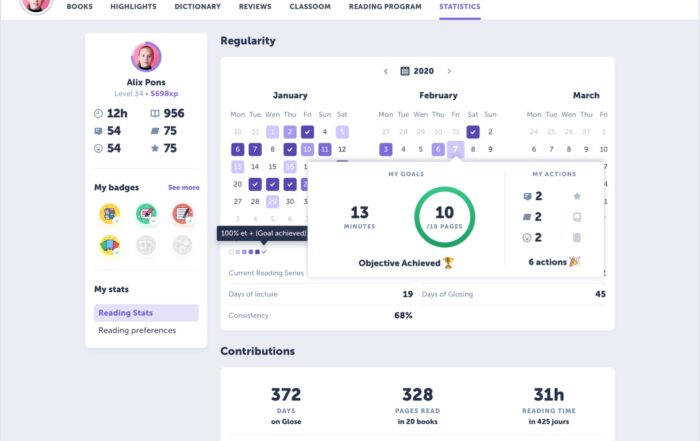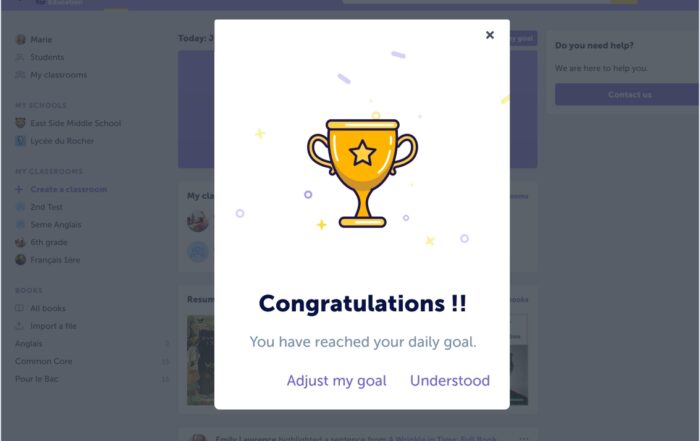Why Reading Scoreboards Should Start “Trending”
Christophe Spy/ September 4, 2020/ Classroom Tips, ELA, Literacy in K-12/ 0 comments
There are many ways to gather and utilize student data in an ELA classroom, which is important because we need data to drive instruction that is timely, relevant, and personalized for every student. Teachers use a range of tools to assess student mastery, from do-nows and exit tickets, to mini bi-monthly learn checks and formalized quarterly assessments. Everything we have our students do is adding data that informs our understanding of their progress. One of my favorite ways to gather data for use in individualizing instruction was our Reading Scoreboard.
A Reading Scoreboard is basically a spreadsheet that tracks the statistics of reading engagement per student and class. It captures the amount of books students have read and worked through and slices the data into subcategories such as amount of pages read per day or number of annotative comments each student has provided.
Why A Scoreboard?
Teachers and students benefit from having a simple system in place to track how students are interacting with books and for how long. A scoreboard allows teachers to easily view patterns and trends to then amp up support for those in need of intervention, affirmation, or extension.
I like to think that collecting, analyzing, and putting data to effective use is one area in which I really excel. That said, it was limited precisely because I had to use Excel.
Now, with Glose for Education, the notion of a Reading Scoreboard has evolved into an exercise in data visualization that ELA teachers can use to gain deep, meaningful insight into how well their students are engaging in the act of reading. If you’re using Glose for Education in your classroom, simply click on the ‘Statistics’ tab to access this data. If you’re exploring whether and how to use Glose, read on for statistical trends that Reading Scoreboards show and how to respond:
Trend: Statistics show students aren’t reading their amount of goal pages a day, nor taking enough annotations.
While looking at the ‘Detailed Activity’ section of your scoreboard, teachers can immediately see the numbers of pages read by students. Notice those that have a lower amount of pages read compared to the group. Match up the amount of pages read to the student’s individual reading goal. If the student isn’t reading close to his or her goal, teachers have two choices: A. change the reading goal to an amount appropriate for the learner, or B. incentivize daily reading targets/pages to encourage students to meet their goals. The same goes for the amount of notes students are taking while reading their books. Instant access to this kind of data means that teachers can focus interventions early and often, helping mitigate the need for more intensive remediation down the road. We have precious little time as it is, so acting quickly is a key benefit to utilizing the Reading Scoreboard.

Trend: Students are easily surpassing their daily goal pages a day
Conversely, if teachers are noticing students that are reading above their daily reading goal and/or making consistent deeper annotations within the text, this is a great opportunity for a 1:1. If students are reading more pages than their goal, it could mean that the text is too easy, which gives you an opportunity to help students ‘level up’ their reading. Alternatively, it may mean that students are, in truth, struggling with the text and skimming through with the hope they go unnoticed. This is where tracking interactions – highlighting, annotations, comments, reveals the full story of a student’s understanding and mastery. Just because a student is fast doesn’t mean that student is demonstrating mastery.


Trend: Scoreboard shows some students select and begin to read multiple books without ever finishing them
When looking at students individually, you may notice that some are ‘tasting’ too many books and are consistently not finishing them. Students that are not able to find appropriate and interesting texts to read require a mini-lesson on how to select ‘just-right’ books. It is normal for all readers to begin a book and change for another when they find it to not be in their interest. Before placing a book into a student’s personal bookshelf on Glose for Education, I like to require that they read the initial set of free pages and provide reflection on why they want to continue reading. This makes sure that they use their purchases on texts that they find interesting and engaging, which will increase their confidence as they begin to read entire books. What I like to point out to teachers is that the reading journey, in its entirety, includes the process of reviewing and selecting books.
Trend: Some students are consistently reading multiple texts that are all the same genre / topic.
While looking at students’ reading statistics, teachers may notice that some students are consistently selecting texts that interest them, meet their goal pages, and finish books. However, if selections closely mimic each other then this may mean a student has a dis-empowered mindset about exploring new topics and genres. As teachers, we have a responsibility to push out students into new areas and challenge them to expand their horizons. I can think of few better ways to do this than through reading. It may be uncomfortable for the student at first, but teachers should encourage and incentivize those students to branch out and try a different type of text every other book. By doing so, teachers stil respect student choice, but continue to hold high expectations of the student in their personal growth.
Trend: Annotations taken by some students aren’t reflecting accurate comprehension of the text.
The ‘Notes’ and ‘Comments’ section of the detailed activity, along with the ‘Contributions’ section of classroom statistics, show an overview of student interactions with the text. Teachers can quickly see the quantity and quality of these interactions. Dive deeper into each student’s feed to review their comprehend ability and deeply responses to the text. Teachers should consistently read through student input to determine understanding of key concepts. If students are not able to succinctly annotate the text, teachers can intervene in a small group setting; pull those students together and review how to annotate the text and define qualities of an exemplar annotation. If students still struggle, encourage those to select a book at a lower lexile level and monitor those text connections to determine if the problem lies in the students’ ability to annotate, or to understand the text. There is great power in ebook platforms precisely because they reveal so much about a reader’s engagement – we have no excuses when it comes to knowing where every student stands on any given day.
Trend: Some students are taking annotations to the extreme by commenting every few lines.
Teachers may notice that some students are trending above the rest of the class in regards to the quantity of annotations. If the student is taking an excessive amount of time to stop and take notes, teachers must first find out the cause. Maybe the student believes they are required to note every new detail or development, or perhaps the student is relying on annotations as a strategy to understand a text that is too difficult for them. Once the student explains the reason, teachers can clear up the misconception through a mini-lesson detailing expectations on when and how to annotate. If the student explains they are using annotations to help them grapple with the complexity of the text, they should be encouraged to select another text that is closer to their current reading level.
Reading Scoreboards are a perfect way to push students in building stronger relationships with reading. When teachers utilize this tool, they are easily equipped with data needed to respond to all students’ learning levels. Students succeed when teachers take an invested interest in their development, especially the development of strong reading skills. Dig deep into the data and enjoy watching your students work through their texts!

About the Author
Samantha Reichard serves as Lead Real Time Teacher Coach for Center City 1 Learning Community in Charlotte, NC, serving as a mission-critical resource for 29 inner-city and Title I schools in the Charlotte Mecklenburg School District. After graduating from the State University of New York at Fredonia, Samantha began her teaching career at East Union Middle School in Union County, NC as an eighth-grade English language arts teacher. After two years, she moved to Charlotte, NC and served as a sixth- and seventh-grade language arts teacher for five years before becoming a multi-classroom leader and real-time teacher coach. Following that, she worked on expanding the model of Multi-Classroom Leader and Real-Time Teacher Coaching (RTTC) for four years at Ranson IB Middle School.
